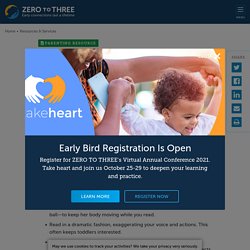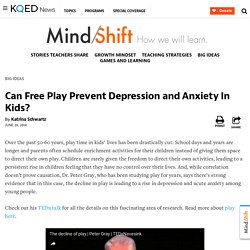

Home - ECEC.
Recommendations and advice - English little kids 1. Alison Gopnik: What do babies think? Yums Theraplay – occupational therapy: empowering families of children with feeding, sensory processing and special needs in their most natural environments. ThePowerofPlay. Symbolic play and language development. 1. Introduction 1.1. Relationship between symbolic play and language Symbolic play, or pretend play, and language are known to be highly interrelated (DeLoache, 2002, McCune, 2010, Smith and Jones, 2011).
Both rely on representational capacity, namely, employing one element as a signifier to represent another element (McCune, 2010). 1.2. Symbolic play begins at the pre-symbolic level, when infants are capable of recognizing the real relationship between familiar objects and their related actions (e.g., drinking from a cup; Fein, 1981, McCune, 1995). 1.3. Language, like symbolic play, begins with basic forms. However, this notion of babbling as a verbal precursor has been challenged since babbling is also shown to follow rhythmic motor activity, such as repetitive arm movements that accompany repetitive vocalization (Iverson et al., 2007). 1.4. Download : Download full-size image Fig. 1. Audio-vocal output during play will begin with babbling. 1.5. 1.6. Fig. 2.
Fig. 3. Fig. 4. Fig. 5. 2. Scientists Say Child's Play Helps Build A Better Brain : NPR Ed. Deion Jefferson, 10, and Samuel Jefferson, 7, take turns climbing and jumping off a stack of old tires at the Berkeley Adventure Playground in California.

The playground is a half-acre park with a junkyard feel where kids are encouraged to "play wild. " David Gilkey/NPR hide caption toggle caption. The cognitive benefits of play: Effects on the learning brain. © 2008 - 2014, Gwen Dewar, Ph.D., all rights reserved Science supports many of our intuitions about the benefits of play.

Playful behavior appears to have positive effects on the brain and on a child’s ability to learn. In fact, play may function as an important, if not crucial, mode for learning. Want specifics? Here are some examples. Animal experiments: Play improves memory and stimulates the growth of the cerebral cortex In 1964, Marion Diamond and her colleagues published an exciting paper about brain growth in rats. When researchers examined the rats’ brains, they discovered that the “enriched" rats had thicker cerebral cortices than did the “impoverished" rats (Diamond et al 1964). The cognitive benefits of play: Effects on the learning brain. I Said I Want the Red Bowl! Responding to Toddlers' Irrational Behavior. Pin It Amelia, told that she can’t have a fifth book before bedtime, shouts: “You are the meanest mommy!

You are not invited to my birthday party!” Derek, when offered a choice between carrots and cheese, not ice cream, before dinner announces: “I don’t like the choices you are choicing me!” Alex hurls a bowl of his favorite cereal off the table and screams, “I said the red bowl, not the blue bowl!” If any of these exclamations sounds familiar, you are not alone. Does my toddler have a short attention span because she won’t sit still for a story? A: It is perfectly normal for toddlers to not sit still very long—period.

Most don’t like to stay in one place for long now that they can explore in so many new ways—by running, jumping, and climbing. So, an adult’s idea of snuggling on the couch to hear a story may not be the same idea a toddler has for story-time. You may only be able to read or talk about a few pages in a book at a time. Assessment of Attention in Preschoolers. Inclusion Development Programme Behaviour Emotional Social Difficulties. B480 Special Need Publication A4 V5 Final MR.
Teaching English to learners with Special Educational Needs (SENs) – Myths and realities. ‘I know I have children with special educational needs in my class, I want to help them and we are supposed to promote inclusion, but I really am not sure how to do this’ Vera, primary teacher from Spain ‘Some of the children in my class are really badly behaved, they can’t sit still, don’t finish their work and are always calling out.

I think they might have a learning difficulty, but I don’t know what to do’ Kris, secondary teacher from Poland. Challenging Learning. Selective mutism. Selective mutism is a severe anxiety disorder where a person is unable to speak in certain social situations, such as with classmates at school or to relatives they don't see very often.

It usually starts during childhood and, left untreated, can persist into adulthood. A child or adult with selective mutism doesn't refuse or choose not to speak, they're literally unable to speak. The expectation to talk to certain people triggers a freeze response with feelings of panic, rather like a bad case of stage fright, and talking is impossible. In time, the person will learn to anticipate the situations that provoke this distressing reaction and do all they can to avoid them. However, people with selective mutism are able to speak freely to certain people, such as close family and friends, when nobody else is around to trigger the freeze response.
A longitudinal investigation of the role of quantity and quality of child-directed speech in vocabulary development. The Power (and Peril) of Praising Your Kids. It didn’t take long.

The teachers—who hadn’t known which students had been assigned to which workshop—could pick out the students who had been taught that intelligence can be developed. They improved their study habits and grades. In a single semester, Blackwell reversed the students’ longtime trend of decreasing math grades. The only difference between the control group and the test group were two lessons, a total of 50 minutes spent teaching not math but a single idea: that the brain is a muscle. Early years in action listening skills for staff. Listening Skills for Staff. How can parents and teachers best educate young children? What principles can both teachers and parents bring to the education of very young children? Gillian Craig, who was part of the Learning Time with Shaun and Timmy writing team, explains. Early Years in Action. How young children learn English through play.
As we release Learning Time with Timmy – our first app for early-years learners of English – Danitza Villarroel, a teacher on our Learning Time with Shaun and Timmy course in Chile, explains the importance of learning through play, and offers a few tips for teachers new to this age group. Teaching English to pre-school children can be daunting for teachers new to this age group. Young children have shorter attention spans than older children and adults, and they're still learning their mother tongue. But teaching these learners can be enormously rewarding once you've taken a few basic principles on board. The importance of active learning.
Ten ways to support your child’s English-learning at home. As the British Council opens a new Learning Time with Shaun & Timmy centre in Mexico for two- to six-year-olds, senior teacher Sarah Reid offers some useful tips for supporting your child’s learning at home. More and more parents want their children to learn English from a young age.
I often meet parents of children as young as two or three who say that proficiency in speaking English will help their child 'get ahead in a globalised world'. In other words, the sooner their children get started, the better. Tell it Again! The Storytelling Handbook for Primary English Language Teachers. How to teach children English using illustrated storybooks. What makes illustrated storybooks such a good resource for teaching young learners of English?
The British Council’s Gail Ellis, co-author of a storytelling handbook for primary English language teachers, explains. Listen to an interview with Gail in our podcast and register for her webinar taking place on Thursday, 2 October. Illustrated storybooks provide an ideal resource for helping children learn English. This is because children love listening to stories. The Important Book - Wikipedia. The Important Book is a 1949 children's picture book written by Margaret Wise Brown and illustrated by Leonard Weisgard.

The book describes various common entities and describes some of their major attributes in brief poetic passages, beginning and ending with what Brown considers the key attribute: The important thing about rain is that it is wet. It falls out of the sky, and it sounds like rain, and makes things shiny, and it does not taste like anything, and is the color of air. But the important thing about rain is that it is wet.— Margaret Wise Brown, The Important Book[1] The American National Education Association listed the book at #92 in its "Teachers' Top 100 Books for Children" list, compiled in 2007.[4]
D467 Storytelling handbook FINAL web (1) MindSet: A Book written by Carol Dweck. Teaching a growth mindset creates motivation and productivity in the worlds of business, education, and sports. Carol Dweck. Further reading _ english in early years. Carol Dweck: The power of believing that you can improve. Effective teacher-child interactions. PowerfulInteractions. The power of positive relationships. BBC World Service - The Documentary, The Language of Lullabies. IPAQ English self admin short. Useful comments and conversations.
LearnEnglish Kids - British Council. Child development plan. Further reading English for children. LearnEnglish Kids - British Council. Don't Expect Toddlers To Behave Consistently — They Literally Can't. Can Free Play Prevent Depression and Anxiety In Kids? Over the past 50-60 years, play time in kids’ lives has been drastically cut.

School days and years are longer and parents often schedule enrichment activities for their children instead of giving them space to direct their own play. Children are rarely given the freedom to direct their own activities, leading to a persistent rise in children feeling that they have no control over their lives. And, while correlation doesn’t prove causation, Dr. Peter Gray, who has been studying play for years, says there’s strong evidence that in this case, the decline in play is leading to a rise in depression and acute anxiety among young people. Check out his TEDx talk for all the details on this fascinating area of research. Which Early Childhood Experiences Shape Adult Life? By Maanvi Singh, NPR Most of us don’t remember our first two or three years of life — but our earliest experiences may stick with us for years and continue to influence us well into adulthood.

Why Empathy Holds the Key to Transforming 21st Century Learning. NQS PLP E Newsletter No36. Teachers TV- A Positive Learning Environment. EducatorsEn. How Are Happiness and Learning Connected? As teachers, we also know that when students' affective filters or defenses are sky high, fight or flight responses will be modus operandi. A room full of defensive behaviors (withdrawn, angry) is a sad, unproductive place to teach and learn. Key Person & Attachment - Early Years Matters. The Key Person. Whole Child Development Is Undervalued. The question is how to make such an approach both systemic and sustainable.
Whole Person Socio-emotional, physical, creative, and cognitive capacities are deeply intertwined and equally important in ensuring a child's wellbeing, learning, and growth. A survival guide for working parents: how to balance family and career. “The obligation for working parents is a precise one: the feeling that one ought to work as if one did not have children, while raising one’s children as if one did not have a job,” a friend recently wrote on Facebook.
Language development opportunities. Talking with Babies and Toddlers June05. Parents articles practical tips english (1) Ten ways to support your child’s English-learning at home. Enable environment. How young children learn English as another language. By Opal Dunn, educational consultant and author. Facebook Clinic Week 5 20 04 17 (1) How can young children best learn languages? The British Council's Tracey Chapelton explains how parents of young children can lay the foundations for success. Earlychildhood NEWS - Article Reading Center. When we first brought our daughter home from the hospital I was inexperienced. LearnEnglish Kids. One theory all teachers with disruptive children should know about.
Imagine a classroom where children are unable to wait their turn or stay focused on their work. They are easily distracted, cannot remember basic instructions or hold enough information in their head to solve problems – skills teachers rely on in order to teach successfully. What to consider when teaching English in large classes.
10 teachers share the books that changed their lives. How to start teaching kids English at home. Stories for children. Practical tips. LearnEnglish Kids. Learning Time With Timmy 1 – Android Apps on Google Play. School Radio - Nursery songs and rhymes. Ey making mark matters76708 1. Music and Movement Activities for Toddlers and Preschoolers. 45+ Quick & Easy Kids Crafts that ANYONE Can Make! LearnEnglish Kids. How to teach children English using illustrated storybooks.